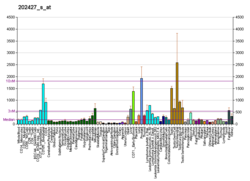Protein-coding gene in the species Homo sapiens
Mitochondrial pyruvate carrier 2 (MPC2) also known as brain protein 44 (BRP44) is a protein that in humans is encoded by the MPC2 gene .[ 5] [ 6] [ 7] protein family .[ 8] pyruvate across the inner membrane of mitochondria in preparation for the pyruvate dehydrogenase reaction .[ 9]
Interactive pathway map [ edit ] Click on genes, proteins and metabolites below to link to respective articles. [ § 1]
[[File:
|alt=Glycolysis and Gluconeogenesis
edit ]]
Glycolysis and Gluconeogenesis
edit
Clinical significance [ edit ] Mutations in the MPC2 gene cause an autosomal recessive disease comparable to the symptoms of Mitochondrial pyruvate carrier deficiency (MPC1 gene).[ 10] [ 10]
^ a b c GRCh38: Ensembl release 89: ENSG00000143158 – Ensembl , May 2017^ a b c GRCm38: Ensembl release 89: ENSMUSG00000026568 – Ensembl , May 2017^ "Human PubMed Reference:" . National Center for Biotechnology Information, U.S. National Library of Medicine .^ "Mouse PubMed Reference:" . National Center for Biotechnology Information, U.S. National Library of Medicine .^ Wiemann S, Weil B, Wellenreuther R, Gassenhuber J, Glassl S, Ansorge W, et al. (March 2001). "Toward a catalog of human genes and proteins: sequencing and analysis of 500 novel complete protein coding human cDNAs" . Genome Research . 11 (3): 422– 435. doi :10.1101/gr.GR1547R . PMC 311072 PMID 11230166 . ^ Tsou AP, Lai C, Danielson P, Noonan DJ, Sutcliffe JG (March 1986). "Structural characterization of a heterogeneous family of rat brain mRNAs" . Molecular and Cellular Biology . 6 (3): 768– 778. doi :10.1128/mcb.6.3.768 . PMC 367577 PMID 3022128 . ^ "BRP44 brain protein 44" . Entrez Gene .^ "mitochondrial pyruvate carrier (MPC) (TC 2.A.105) family" . UniProt .^ "Pyruvate transmembrane transporter activity" . QuickGO . EMBL-EBI.^ a b Pujol C, Lebigot E, Gaignard P, Galai S, Kraoua I, Bault JP, et al. (March 2023). "MPC2 variants disrupt mitochondrial pyruvate metabolism and cause an early-onset mitochondriopathy" . Brain . 146 (3): 858– 864. doi :10.1093/brain/awac444 . PMC 9976959 PMID 36417180 . Hartley JL, Temple GF, Brasch MA (November 2000). "DNA cloning using in vitro site-specific recombination" . Genome Research . 10 (11): 1788– 1795. doi :10.1101/gr.143000 . PMC 310948 PMID 11076863 . Simpson JC, Wellenreuther R, Poustka A, Pepperkok R, Wiemann S (September 2000). "Systematic subcellular localization of novel proteins identified by large-scale cDNA sequencing" . EMBO Reports . 1 (3): 287– 292. doi :10.1093/embo-reports/kvd058 . PMC 1083732 PMID 11256614 . Wiemann S, Arlt D, Huber W, Wellenreuther R, Schleeger S, Mehrle A, et al. (October 2004). "From ORFeome to biology: a functional genomics pipeline" . Genome Research . 14 (10B): 2136– 2144. doi :10.1101/gr.2576704 . PMC 528930 PMID 15489336 . Mehrle A, Rosenfelder H, Schupp I, del Val C, Arlt D, Hahne F, et al. (January 2006). "The LIFEdb database in 2006" . Nucleic Acids Research . 34 (Database issue): D415 – D418 . doi :10.1093/nar/gkj139 . PMC 1347501 PMID 16381901 .
 From Wikipedia the free encyclopedia
From Wikipedia the free encyclopedia




